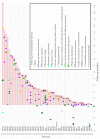Systemic Pulmonary Events Associated with Myelodysplastic Syndromes: A Retrospective Multicentre Study
- PMID: 33802067
- PMCID: PMC7999053
- DOI: 10.3390/jcm10061162
Systemic Pulmonary Events Associated with Myelodysplastic Syndromes: A Retrospective Multicentre Study
Abstract
Although pulmonary events are considered to be frequently associated with malignant haemopathies, they have been sparsely studied in the specific context of myelodysplastic syndromes (MDS). We aimed to describe their different types, their relative proportions and their relative effects on overall survival (OS). We conducted a multicentre retrospective cohort study. Patients with MDS (diagnosed according to the 2016 WHO classification) and pulmonary events were included. The inclusion period was 1 January 2007 to 31 December 2017 and patients were monitored until August 2019. Fifty-five hospitalized patients were included in the analysis. They had 113 separate pulmonary events. Thirteen patients (23.6%) had a systemic autoimmune disease associated with MDS. Median age at diagnosis of MDS was 77 years. Median time to onset of pulmonary events was 13 months. Pulmonary events comprised: 70 infectious diseases (62%); 27 interstitial lung diseases (23.9%), including 13 non-specific interstitial pneumonias and seven secondary organizing pneumonias or respiratory bronchiolitis-interstitial lung diseases; 10 pleural effusions (8.8%), including four cases of chronic organizing pleuritis with exudative effusion; and six pulmonary hypertensions (5.3%). The median OS of the cohort was 29 months after MDS diagnosis but OS was only 10 months after a pulmonary event. The OS was similar to that of the general myelodysplastic population. However, the occurrence of a pulmonary event appeared to be either an accelerating factor of death or an indicator for the worsening of the underlying MDS in our study. More than a third of pulmonary events were non-infectious and could be systemic manifestations of MDS.
Keywords: iatrogenic effects; interstitial lung disease; pleuritic effusion; pneumonia; pulmonary alveolar proteinosis; pulmonary hypertension.
Conflict of interest statement
STERVINOU-WEMEAU reports personal fees and non-financial support from Roche, personal fees and non-financial support from Boehringer-Ingelheim, personal fees from BMS, personal fees from Sanofi Genzyme, and personal fees from GSK, outside the submitted work. Prof. LAUNAY reports grants from CSL Behring, personal fees from Biocryst, grants and personal fees from Takeda, outside the submitted work. The other authors have nothing to disclose.
Figures






References
-
- Arber D.A., Orazi A., Hasserjian R., Thiele J., Borowitz M.J., Beau M.M.L., Bloomfield C.D., Cazzola M., Vardiman J.W. The 2016 Revision to the World Health Organization Classification of Myeloid Neoplasms and Acute Leukemia. Blood. 2016;127:2391–2405. doi: 10.1182/blood-2016-03-643544. - DOI - PubMed
-
- Mekinian A., Dervin G., Lapidus N., Kahn J.-E., Terriou L., Liozon E., Grignano E., Piette J.-C., Rauzy O.B., Grobost V., et al. Biologics in Myelodysplastic Syndrome-Related Systemic Inflammatory and Autoimmune Diseases: French Multicenter Retrospective Study of 29 Patients. Autoimmun. Rev. 2017;16:903–910. doi: 10.1016/j.autrev.2017.07.003. - DOI - PubMed
LinkOut - more resources
Full Text Sources
Other Literature Sources
Research Materials
Miscellaneous

